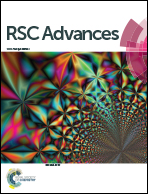Dependence on co-adsorbed water in the reforming reaction of ethanol on a Rh(111) surface†
Abstract
We have studied the reforming reaction of ethanol co-adsorbed with atomic oxygen (O*, * denotes adspecies) and deuterated water (D2O*) on a Rh(111) surface, with varied surface probe techniques under UHV conditions and with density-functional-theory calculations. Adsorbed ethanol molecules were found to penetrate readily through pre-adsorbed water, even up to eight overlayers, to react at the Rh surface; they decomposed at a probability promoted by the water overlayers. The production probabilities of H2, CO, CH2CH2 and CH4 continued to increase with co-adsorbed D2O*, up to two D2O overlayers, despite separate increasing rates; above two D2O overlayers, those of H2, CO and CH2CH2 were approximately saturated while that of CH4 decreased. The increased (or saturated) production probabilities are rationalized with an increased (saturated) concentration of surface hydroxyl (OD*, formed by O* abstracting D from D2O*), whose intermolecular hydrogen bonding with adsorbed ethanol facilitates proton transfer from ethanol to OD* and thus enhances the reaction probability. The decreasing behavior of CH4 could also involve the competition for H* with the formation of H2 and HDO.



 Please wait while we load your content...
Please wait while we load your content...